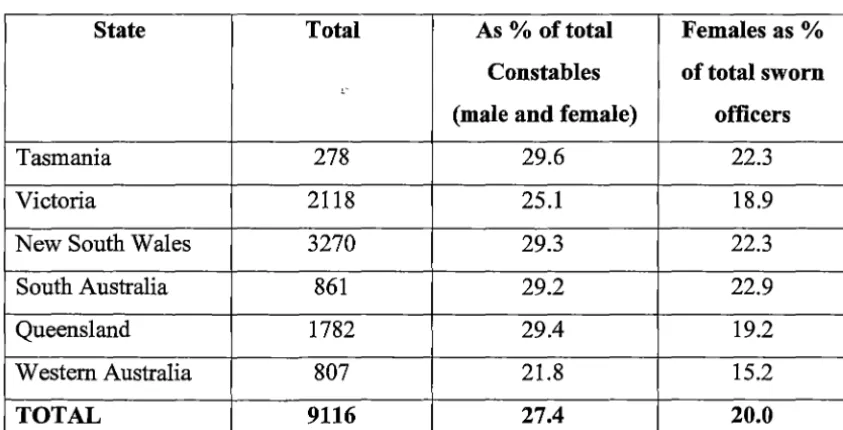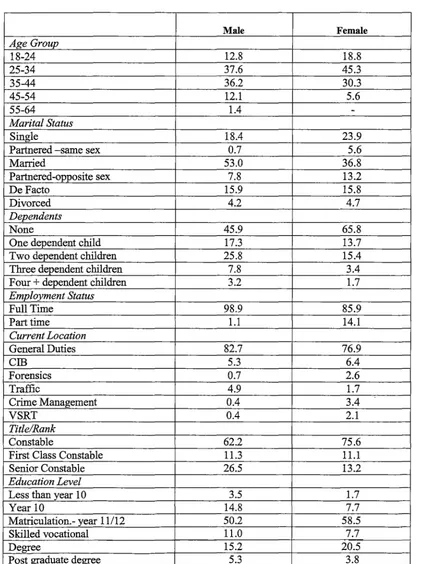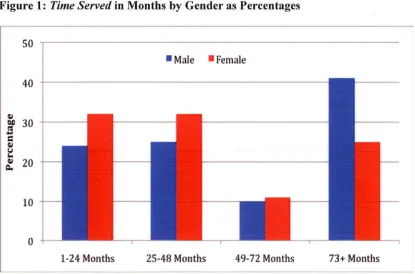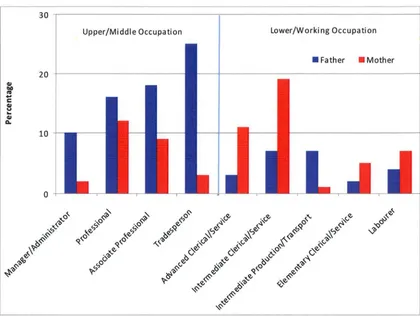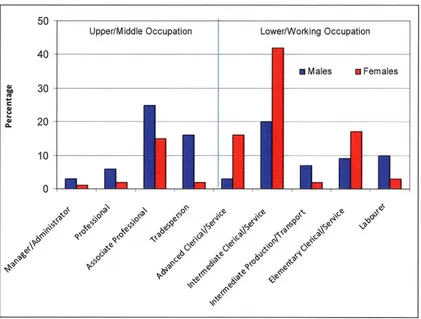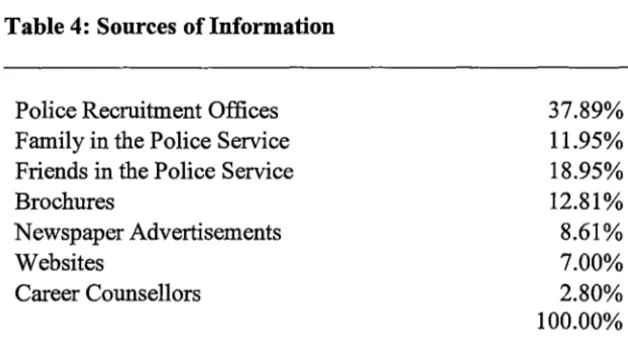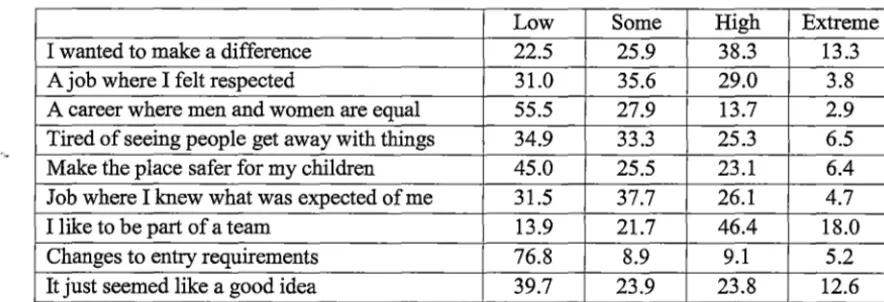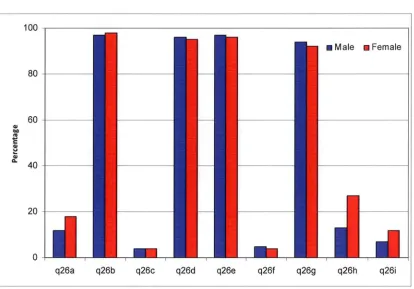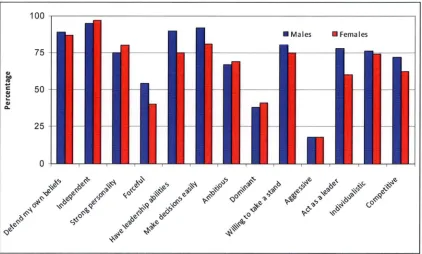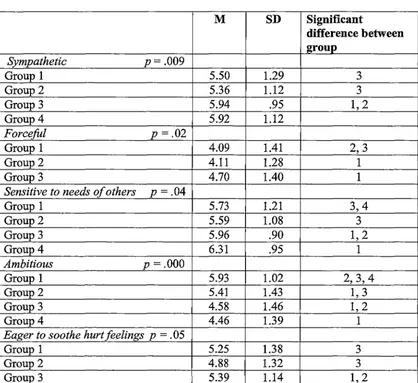. " _,
) ,
- '
'.
'
/Policing-A Gendered Experience?
The influence of socialisation and gender identity on the
choice of a career in policing.
by
Barbara A. Stewart B.A. (Hons)
Submitted in fulfilment of the requirements
for the Degree of
Doctor of Philosophy
Tasmanian Institute of Law Enforcement Studies
School of Government
University of Tasmania
This thesis contains no material which has been accepted for a degree or diploma by
the University or any other institution, except by way of background information
and duly acknowledged in the thesis, and to the best of my knowledge and belief no
material previously published or written by another person except where due
acknowledgement is made in the text of the thesis, nor does the thesis contain any
material that infringes copyright.
This thesis may be made available for loan and limited copying in accordance with
the Copyright Act 1968.
The research associated with this thesis abides by the requirements of the
Acknowledgements
Thanks to my Supervisor, Associate Professor Roberta Julian, for your direction
and encouragement in the development of this thesis. Thanks to all in the
Tasmanian Institute of Law Enforcement Studies and also the School of Sociology
at the University of Tasmania who offered support and encouragement. Special
thanks to Dr. Warren Sproule, the most intelligent person I know, for your support
and encouragement over my years at University and for repeatedly telling me "Of
course you can". Thanks to other special helpers such as Felicity Picken -friends
like you are hard to find; my brother Graeme Harvey and sister Dorothy Calvert- for
your support and keeping my brain 'lubricated'; and Phil Patman- for your guidance
with SPSS. Thanks also to the Sociology Office ladies Lyn, Della, Andrea and
Denise- you have been wonderful.
To the many police officers from TasPol, VicPol and W APol I met during this
research, especially the policewomen who volunteered for interviews and
observations - my gratitude and respect. It's a tough job and you do it well. Thank
you.
To my children Aron Harvey, Renee Stewart and Samantha Stewart - I hope you are
Abstract
Few occupations have been so fully defined as masculine and as resistant to the
integration of women as policing (Martin 1996). Despite nearly 100 years of female
involvement women officers continue to contest negative stereotypes that present an
image of women as unsuitable for police work. This research examines the
contextual influences on constables' choice of policing as a career with an emphasis
on female constables. Firstly, the research investigates whether there is a
relationship between perceptions of policing as a suitable career option and
individual socialisation. The primary factor identified in the literature as influencing
career choice is gender socialisation - within the family, from significant others,
through educational institutions and within the workplace. This factor is related to
the development of personal attributes such as self-esteem and perceptions of
gender-appropriate activities. Further, the research examines whether a
policewoman's gender identity influences her experience of policing. A conceptual
:framework was developed integrating Bourdieu's (1990) concepts of 'habitus'
'field' and 'culture', Connell's (2002) concept of 'negotiated gender' and
Messerschmidt's (2002) concept of situated gender performance. The research was
conducted within Western Australian, Victorian and Tasmanian police services
using a mixed methods approach: that is, a survey distributed to both male and
female police constables; interviews with female police constables and observations
in the police workplace. The findings suggest that there are more similarities than
differences between male and female officers. Although different socialisation
factors are involved, both male and female officers were found to have low
attachment to stereotypical gender expectations and similar levels of self-esteem.
Overall, female officers had higher levels of education. and provided more evidence
ofleadership potential than their male counterparts. In interviews and observations
it was found that while police culture is influential on policing practice, female
officers are negotiating gender and using agency to change the way policing is
performed. These findings have implications for the development of recruitment
and retention strategies for police services and contribute to a sociological
understanding of the relationship between gender socialisation, career choice and
Contents
Introduction ... 11
Chapter l_Setting the Scene ... 21
1.1 Introduction ... 21
1.2 A brief history of policewomen in Australia ... 22
1.3 Police Culture and 'Doing Gender' ... 28
1.4 Conclusion ...•... 31
Chapter 2_Socialisation, Identity and Career Choice ... 34
2.1 Introduction ... 34
2.2 Self Identity and Social Identity ... 35
2.3 Gender Socialisation, Gender Identity and Career Choice ... 39
2.4 Gender Socialisation within the Family ... 40
2.5 Gender Socialisation - from School to Work ... 42
2.6 Women in the Workplace ... .' ... 45
2. 7 Women and Masculinised Workplaces ... 4 7 2.8 Women in Policing ...
!···'·
492.9 Summary ... 50
Chapter 3_Agency, Gender Socialisation and Performativity of Gender ... 51
3 .1 Introduction ... 51
3.2 The Importance of Agency in Gender Socialisation ... 52
3.3 Perspectives on Gender ... 55
3.3.1 Functionalism ... 55
3.3.2 Liberal Feminism ... 58
3.3.3 Radical Feminism ... 59
3.3.4 Marxist-Feminism ... 61
3.3.5 Feminist Deconstruction Theories ... 62
3.4 'Doing Gender' ... 66
3.5 Building a Conceptual Framework ... 73
Chapter 4_Methodology and Methods ... 77
4.1 Introduction ... 77
4.2 Selecting the Sample ... 78
4.3 Research Approach ... : ... 80
4.4 Methods ... 81
4.5 Survey ... 82
4.6 Survey Approach ... 82
4.7.1 Family ... 84
4.7.2 Education ... 85
4.7.3 Self Perceptions ... 86
4.7.4 Gender Orientation ... 86
4.8 Analysing the Survey ... 88
4.9 Interviews ... 88
4.10 Aim and rationale of Interviews ... 89
4.11 Recruiting the Sample ... 91
4.12 Description of the Sample ... 92
4.13 Interview Process ... 93
4.14 Analysing Interview Data ... 95
4.15 Observations ... 95
4.16 Approach and rationale of Observations ... 96
4.17 Entering the Police Setting ... 98
Chapter 5_The Influence of Institutional Structures on Gender Socialisation ... 101
5.1 Introduction ... 101
5.2 Family Background ... 105
5.3 A Career in Policing ... 109
5.4 SelfPerceptions ... 111
5.5 One-Way Analysis ofVariance ... 116
5.6 Independent Sample t-tests ... .-... 125
5.7 Standard Multiple Regression ... 128
5.8 Summary of Survey Data by Gender ... 133
5.8.1 Summary of Female Data ... 133
5.8.2 Summary of Male Data ... 135
5.9 Discussion ... 137
5.10 Conclusion ... 140
Chapter 6 _Gender Socialisation and Career Choice ... 141
6.1 Introduction ... 141
6.2 The Family of Origin ... 142
6.3 Parental Employment ... 143
6.4 Family Life ... 144
6.5 Memories of Childhood ... 144
6.6 Tomboy Resistance? ... 145
6.8 Education -School Type ... 147
6.9 Experiences in Primary School ... 148
6.10 Experiences in Secondary School ... 149
6.11 Achievement, Self Efficacy and Agency ... 150
6.12 Failure is Not an Option ... 152
6.13 Major lnfluence ... 152
6.14 Previous Employment ... 154
6.15 Motivation ... 154
6.16 Discussion ... : ... 156
Chapter 7_Doing Gender/Doing Policing ... 158
7.1 Introduction ... 158
7.2 Negotiating police culture ... 159
7.2.1 'Fittin~ in' ... 160
7 .2.2 Knowing where the 'line' is ... 160
7.2.3 To Change or Not to Change? ... 161
7 .2.4 One of the Boys? ... 162
7.3 Maintaining 'masculine' discourses ... 164
7.3.1 Being too 'girly' ... 164
7 .4 Maintaining 'femininity' ... 165
7.5 Maintaining the Status Quo ... 166
7.5.1 Sexualisation of the Workplace ... 166
7.5.2 Generalising Female 'Failure' ... 167
7.5.3 Stereotyping Activities ... 168
7.5.4 Promotion ... 170
7.6 'It's a job, not my life'- Perceptions of the Policing Role ... 170
7.7 'Doing' Policing ... 171
7. 7 .1 Doing it Like the Boys ... 1 72 7.7.2 Perspectives on a Need for Physical Force ... 173
7.7.3 The Problem of Male Aggression ... 174
7.8 'Doing' Gender while 'Doing' Policing ... 175
7.8.1 Doing Policing Differently ... 176
7.8.2 Different approaches -working with a policewoman or a_policeman ... 177
7 .9 Self Confidence and Interaction ... 178
Chapter 8_Discussion and Conclusion ... 182
8 .1 futroduction ... 182
8.2 Approach ... 182
8.3 Summary and Discussion of Research Findings ... 183
8 .4 hnplications of the Research ... 192
8.5 Limitations and Further Research ... 194
8.6 Conclusion ... 194
References ... 197
Appendices ... 217
Appendix A - fuformation Sheet for Surveys ... 217
Appendix C - futerview Schedule ... 224
Appendix D - fuvitation to policewomen to participate in futerviews ... 225
Appendix E (a) - fuformation Sheet for Interviews ... 226
Appendix E (b) - Consent Form for futerviews ... 228
Appendix F (a) - fuformation Sheet for Observations ... 229
List of Tables
Table 1: Police officers holding the rank of Sergeant and above as at June. 2006 .. 79
Table 2: Females holding the rank of Senior Constable, First Class Constable ... 79
Table 3: Descriptive Frequencies of the Survey Sample as Percentages ... 102
Table 4: Sources of Information ... 109
Table 5: Importance of Statements in the Decision to Become a Police Officer ... 110
Table 6: Influence of Age on Personal Qualities for Females ... 116
Table 7: Influence of Age on Personal Qualities for Males ... 117
Table 8: Influence of School Type on Personal Qualities for Males ... 118
Table 9: Influence of Family Type (0-14 years) on Self Perceptions for Females.119 Table 10: Influence of Birth Order on Personal Qualities for Males ... 121
Table 11: Influence of Marital Status on Self Perceptions and Personal Qualities ... 122
Table 12: Influence of Marital Status on Personal Qualities for Males ... 122
Table 13: Influence of Educational Attainment on Personal Qualities for Males.124 Table 14: Influence of having an Employed Father on Personal Qualities by Gender ... 125
Table 15: Influence of having an Employed Mother on Personal Qualities by ... 127
Table 16: Regression on Motivation for Males ... 129
Table 17: Regression on Motivation for Females ... 129
Table 18: Regression on Self Perceptions by Gender ... 130
Table 19: Regression on Personal Qualities for Males ... 131
List of Figures
Figure 1: Time Served in Months by Gender as Percentages ... 104
Figure 2: Occupation of Mother and Father as Percentages ... 107
Figure 3: Combined Responses for Previous Occupations of Respondents ... 108
Figure 4: Self Perception by Gender as Percentages ... 112
Figure 5: Ratings on Instrumentality by Gender as Percentages ... 114
Introduction
"It takes a special kind of woman to fit in, because it really is a big Men's Club"
(Male police officer: 2003)
Several years ago, during an interview, a male police officer remarked that it takes
'a special kind of woman' to be a police officer. Women generally choose
employment in female friendly or gender neutral occupations, but according to
Martin (1996), few occupations have been so fully defined as masculine and as
resistant to the integration of women as policing. An occupation is considered male-dominated if at least 67% of the employees are male (Willets-Bloom & Nock
1994:12). According to the Australian Institute of Criminology (AIC), in 2006,
women officers of all ranks constituted less than 20% of sworn state police officers.
Although the number of policewomen has been slo'wly increasing it is still low, and
the majority are situated in the lower ranks. It has been argued that in Australia,
policing represents 'an almost pure form of hegemonic masculinity' (Brown and
Heidensohn 2000:84). Despite an increase in the number of women entering
policing, a significant gender imbalance remains. Gender imbalance and an
inherently masculinised workplace culture pose specific problems for women
entering male-dominated occupations (Bradley 1998).
A brief history of policewomen in Australia illustrates how women have faced
sustained resistance to their presence, at both the organisational and cultural level,
and across time and jurisdiction. Recent research evidence suggests their present
day contemporaries continue to face obstacles in the form of sexual harassment and
discrimination in deployment and promotion ( cf. Prenzler 2002; Prenzler and Hayes
2000; Eveline and Harwood 2002; Boni and Circelli 2002). Police selection and
training procedures, supervisory practices, organizational hierarchies, ideologies,
interactions, work groups and activities are all infused with gendered practices,
images and consequences. The occupation is still far from gender-neutral and
women's opportunities continue to be restricted by the gendered work culture
(Adams 2001). Deployment patterns differ to men's advantage and sexual
discrimination and gender-related barriers pose career difficulties for women
career choice. Why do some women self-select a career in policing, given its
acknowledged status as a male-dominated organisation?
The central focus of the thesis is to address the following key questions.
Does socialisation, especially the construction of gender identity, influence
individual perceptions of policing as a suitable career choice?
Further, does a policewoman 's gender identity irifluence her experience of policing
i.e. is there a relationship between 'doing gender' and 'doing policing'?
Despite increased research into women in policing over the past two decades, most
studies have focused on barriers facing women after they become officers. There is
a scarcity of research examining what motivates women to enter police services in
the first instance. This study examines the motivations and perceptions of
Australian policewomen in relation to policing as a career choice. Further, the
study investigates whether there is a relationship between individual socialisation
and perceptions of policing as a suitable career option. Finally the study observes
policewomen at their place of work, to identify how they perform gender in a
masculine workplace.
Synopsis of the research
In order to establish the masculinised nature of policing and the difficulties faced by
women entering the occupation, a review of the literature relating to the history of
women in policing in Australia is presented in Chapter 1. A discussion of police
culture is also presented to illustrate its purported influence on the way
policewomen have defined their roles and practices.
The main factors identified in the literature as influencing career choice relate to
socialisation, particularly gender socialisation - within the family, from significant
others, through educational institutions and within the workplace ( cf. Crespi n.d ;
Connell 1995:30; Richmond 1996:32; Lord & Friday 2003:69; Bernes et al.2005:1;
Kniveton 2004:47; Foster 1998). These factors can be related to the development of
personal attributes such as self-efficacy, self-esteem and perceptions of
gender-appropriate activities (Lord & Findlay 2003:66; Adams 2001:14). Therefore, the
first area of inquiry was participants' experiences of gender socialisation,
A review of the literature identified that ge11-der stereotypes are maintained and
transmitted through sources such as parents, peers, teachers, religious leaders and
the mass media, but gender expectations can and do vary over time and place
(Richmond 1996:26; Baxter & Gray 2003; Dykstra et al. n.d.:20). Parents may teach
stereotypes through different behaviours towards and expectations of their children,
for example the way they dress the child, the toys they give and parental behaviour
and attitudes (Crespi n.d.; Bittman 1991; Dempsey 1988). As Richmond (1996:32)
notes, 'Our selves are largely constructed within our families, which in turn are
shaped by wider social contexts'.
Research (Baxter, Gibson and Lynch-Blosse 1990; Richmond 1996; Crespi n.d.;
Dempsey 1988; Crompton 1997; Gershing 1994) has shown that 'traditional'
gender attitudes of parents are reflected in the traditional division of labour
arrangements within families, i.e. the woman responsible for domestic work, the
man as 'breadwinner'. In such families there is an increased likelihood that the
children will also hold these attitudes. However, with age, increased self-esteem and
status, females are more likely than males to adopt less stereotypical attitudes
towards gender (Crespi n.d.).
With the increasing participation of women in the workplace, and an increased
proportion of 'two career' families, the idea of a woman's role as mother and
housewife is becoming muted although women continue to perform the majority of
family-related tasks (Bittman 1995; Baxter, Gibson and Lynch-Blosse 1990; Crespi
n.d.). However, less stereotypical gender attitudes have been found in families
where the mother is employed (Sennett 1998; Witt 1997).
Another area identified in the literature as relating to career choice is education. In
recent years Australia has experienced a move towards gender equity in schooling
(Foster 1998: 1; Weiner et al. 1997). However this ~oes not appear to have led to a
significant change in girls' lived e_xperiences of schooling, or post-school outcomes.
Despite an increase in the number of girls successfully participating in previously
male dominated subject areas, such as Maths and Physics, they continue to face
Some factors identified to account for the unequal outcomes of education for girls
include their greater domestic and family responsibilities, lack of teacher
understanding of gender equity, a belief that sexual harassment does not exist in
schools and gender issues not being addressed in classrooms (N.S.W. Dept. of
School Education 1994:ii). Studies have found that 'active though not always
articulate politics of gender' are present in all schools, with staff and students
performing practices which 'construct various kinds of masculinity and femininity'
and perpetuate an ideology about sexual behaviour and sexual character (Connell
1995:30). Although the patterns formed vary between schools, it does so 'within
limits that reflect the balances of sexual politics in Australian society generally'
(Connell 1995:30). Foster notes that the curriculum and practices of schooling
maintain a social reality which endorses the injunction that women should be the
providers of care, socialisation and regulation of boy's classroom and general
school behaviour (1998:10).
Successful completion of school does not appear to be translating to better career
outcomes for girls. Foster suggests this may be due to different male and female
orientations to the concept of 'career', which has only relatively recently been
applied to women. Furthermore, for girls to achieve self-efficacy and equality
within the co-educational system, they need to find a place between the
masculinised public realm of the school and the private realm of the female,
violating public-private norms (Foster 1998:6). An interesting finding of the Australian Education Council (1992) is that girls achieve better outcomes and
develop higher self efficacy in single-sex schools in a climate devoid of male sexual
harassment and hostility to girls. The influence of these agents of socialisation on
gender attribution and identity are reviewed and discussed in Chapter 2.
The next step in the research was to examine various theoretical perspectives on
gender and gender socialisation. Functionalist approaches (cf. Parsons 1952;
Parsons & Bales 1956) maintain that gender expectations are mainly learned,
modified and enlarged through the family, education, peers and the workplace.
From this perspective, clearly defined expectations and values concerning
appropriate gender attributes are constantly reflected back to individuals, and are
socialisation we learn what our society and culture considers appropriate and
inappropriate behaviour for both genders. It is a relational process between a person
(as child, adolescent and adult) and their family, peers and work mates, through
which self identity, in this case gender identity, is formed.
However, post-structuralist approaches to gender construction argue that individuals
develop subjectivities either in agreement with, or in opposition to, dominant
expectations. Masculinity and femininity are learnt in specific social environments,
and their meaning can vary from one social context to another. People face input
from a variety of different people and social environments and can reject aspects of
their gender socialisation, choosing to resist the imposition of male-female dualisms
and constructing identities which challenge stereotypes and partially transcend
traditional gender roles (Wearing 1996:187; Connell 1987; Richmond 1996:23-25).
The relationships of power are neither one way, nor static, and there is always the
possibility for individual resistance, negotiation and reconstruction.
Debates in the sociological literature on socialisation and gender identity highlight
the dynamic relationship and tensions between structure and agency. A challenge
for this research was to develop both a theoretical and methodological approach
which addresses the complexities of this structure/agency divide. While it is
acknowledged that structures and institutions exert an influence on individuals,
individuals also influence and reproduce structures i.e. structure impacts on
individual agency and individual agency impacts on structures. I have chosen a
relatively flexible theoretical :framework for the research, incorporating the
perspectives of several approaches in order to address the tension between the
structural and agential factors relating to the research questions. These include
Connell's (2002) 'negotiated gender' approach and Messerschmidt's (2002)
adaptation of West and Zimmerman's (1987) 'doing gender' approach. Bourdieu's
(1990) concepts of 'habitus', 'field' and culture are also used to examine the ways
in which structure and agency interact in career choice and individual performance
of policing duties at the level of the individual.
Such a framework allows for consideration of post-structural approaches, in that it
and discourse' and recognises that particular discursive practices privilege some and
maintain certain ways of social life (Seidman 2008: 158,161). While it is
acknowledged that post-structuralist approaches may be seen as incommensurate
with more orthodox accounts of socialisation, my approach 'loosens up' some of
the structural determinism to which socialisation accounts often fall prey, giving
fuller weight to subjectivities and agencies, and clarifying why some individuals
resist the dominant paradigm. Agency, gender socialisation and performativity of
gender are discussed in Chapter 3. The conceptual framework is also discussed in
this chapter.
The low numbers of women in policing influenced both the selection of research
methods and the decision to include only constables in the research sample. Women
officers above this rank constitute a small minority in policing in all Australian
states. The low numbers of female officers in positions of authority in comparison
to female constables meant that female constables provided a more suitable basis
for the recruitment of research participants.
Methods and methodology are discussed in detail in Chapter 4. I decided to adopt a
mixed method approach using both quantitative and qualitative research methods.
This included a survey; semi-structured interviews; and observations. Some are best
collected and analysed statistically, in order to establish the existence of patterns
and define particular areas requiring further, more detailed examination. As an
initial method of inquiry a survey was developed. The survey forms the foundation
for inquiry for the interviews, drawing mainly on those factors identified in the
literature as influencing career choice-the family, education and the workplace. It
consists of 29 questions in two main sections and was designed to collect data
relevant to the first research question, that is, the influence of socialisation on career
choice. The first section was formulated to obtain demographic, occupational and
biographical data relevant to the participant and their immediate family.
Demographic data collected included age, marital status, dependents, length of
service and current rank. Agencies of socialisation such as type of school attended,
previous employment and whether one or both parents were employed during the
The second section of the survey addressed two other influential factors in
occupational choice -self esteem, and the extent to which individual's identify with
stereotypical gender expectations. Self esteem refers to an individual's belief that
they have the ability and skills in relation to the requirements of an occupation
(Lord & Findlay 2003:66; Adams 2001 :14). Self esteem was measured in the
survey using Rosenberg's (1965) Self Esteem Scale, adapted by Adams (2001).
Although societal expectations of gendered behaviours are changing, the extent to
which an individual identifies with stereotypical gender expectations remains an
important factor in career choice, particularly when a career is non-traditional for
one's gender (Kent and Moss 1994:1335).The most commonly-used instrument for
measuring traditionally masculine and feminine characteristics, or gender
stereotypes is Bern's Sex Role Inventory (BSRI). A scale based on the BSRI, and
developed by Heifer, Knoll, Olsen and Salon (cited in Adams 2001: 15) was used to
measure gendered world views. The measures rate levels of instrumentality and
expressivity. Instrumentality suggests a goal orientation and a general insensitivity
to the responses of others. Expressivity suggests sensitivity to others' responses and
a concern with interpersonal relationships. Androgyny in this instance is identified
as the combined presence of socially valued, stereotypical characteristics of
masculinity (instrumentality) and femininity ( expressivity).
The survey was mailed to 1440 randomly-selected male and female police
constables serving in Tasmania, Western Australia and Victoria police services.
Data were analysed using univariate, bivariate and multivariate techniques in SPSS,
with statistical significance established at the .05 alpha level. Results and a detailed
discussion of the survey findings are presented in Chapter 5.
In order to gain an understanding of what influenced participants to apply for a
career in policing and whether the influences were related to socialisation,
semi-structured, in-depth interviews were conducted with volunteer female officers
serving in urban and rural stations in Tasmania, Victoria and Western Australia.
The interviews provided an opportunity to elicit information relating to individual
participant's experiences of gendering within the family, educational institutions,
investigate whether an identifiable relationship can be discerned between
experiences of gender socialisation and policing as a suitable career choice.
Further, information was obtained on participants' experiences within policing, how
they saw themselves as 'fitting in' to the masculine workplace and how they
performed their duties. While some questions were standard to all interviews, the
interview process was guided by individual responses.
The objective of the interviews was to elicit narratives from the participants by
inviting them to give their own accounts about specific times and situations in their
lives, in order to identify the presence of agency and sources which could have
influenced the high levels of self efficacy and confidence detected in the survey
sample. An interview schedule was prepared, with questions focusing on the main
areas of inquiry and areas of interest identified in the survey. Analysis of interview
was conducted using thematic analysis, with a specific focus on the interaction
between structure and agency.
"
The interviews are reported in two chapters. Interview data and discussions
presented in Chapter 6 focus on family of origin, educational experiences, social life
and activities outside of school hours, previous employment and motivation to
apply for a career in policing. Participants' positive and negative experiences within
policing, with a focus on how a policewoman's gender identity influences her
experience of policing, that is, the relationship between 'doing gender' and 'doing
policing', are discussed in Chapter 7.
Observations were conducted using an ethnomethodological approach. This
approach was chosen because ethnomethodology is useful for examining the
methods through which ordinary people 'understand their world and decide how to
manoeuvre through it' (Collin 1997:27). The approach is particularly useful when
studying institutions such as police, which appear to be bound by strict rules and
work procedures. The public sphere of policing is prone to stereotypical
performances and has been well researched. In order to minimise the risk of this
interfering with the research focus, observations were conducted in the informal
spaces of policing. This is an area where a large amount of policing is undertaken,
urban and suburban, in a variety of police work settings in Western Australia and
Tasmania. Due to time constraints it was not possible to conduct observations with
Victoria Police.
Observational data is incorporated with interview data in Chapter 7, in order to
enhance the discussion through complimentarity, illustration and elaboration where
appropriate. The aim of the analysis in this chapter is to acknowledge the
performativity of gender and embodiment of policewomen within Bourdieu's
concepts of 'field' and 'habitus', with a focus on policing 'habitus'. These concepts
represent the structural conditions of policing and the learned dispositions of police
respectively. Specifically, the discussion focuses on the agency of policewomen in
relation to their work environment.
The findings of this research suggest that there are more similarities than
differences between male and female officers although different socialisation
factors are involved. Both male and female officers were found to have low
attachment to stereotypical gender expectations and male and female self-esteem
was also similar. Overall, female officers had higher levels of education and
provided evidence ofleadership potential. In interviews and observations it was found that, while police culture is influential on policing practice, female officers
are using agency and negotiating gender, changing the way policing is performed. A
summary of the major research findings is presented in Chapter 8.
The study fills a gap in the research literature, since there are few studies of
women's motivations in seeking employment in traditionally masculine
occupations. This research has broad implications for masculinised workplaces and
paramilitary organisations, and specific implications for female recruitment and
retention strategies in police organisations. For example, findings suggest that
continued development and refinement of flexible policies, undertaken in
consultation between senior staff and general staff, would ensure that
policewomen's needs are actually being met. Further, the development of
cross-gender mentoring programmes wherein senior male officers support and encourage
females to achieve promotion may assist with the problem of the low numbers of
make an important contribution to aspects of both occupational sociology and the ,-•
sociology of gender. Relevant implications arising from the study, suggested
directions for future research and a conclusion are also provided in Chapter 8.
Chapter 1 presents a review of the literature relating to the history of policewomen
in Australia to situate the research and a discussion of police culture to illustrate its
1.1 Introduction
Chapter 1
Setting the Scene
The integration of women into policing in Australia perhaps owes more to the
courage of women who undertook litigation and challenged prevailing orthodoxies
than to equal opportunity legislations or social justice motives in police
organisations. Historically, employment of policewomen was seen as a 'desperate
measure' in times oflabour shortage or some other crisis (cf. Natarajan 2008:13);
for example, concerns about women's morals or as a response to various inquiries
into police practice and corruption, such as the Fitzgerald Inquiry. Traditionally,
conservative discourses have been routinely deployed to either deprofessionalise or
defeminise policewomen. These discourses continue to construct policewomen in
particular ways, with a specific focus on the body of the woman officer as frail,
weak body; as seductive body, or; as pregnant/mothering body, all of which fulfil
societal gender expectations and deprofessionalise policewomen. Alternatively,
discourses constructing policewomen who show they are capable of police work as
'unnatural' maintain and reinforce the image that policing is an unsuitable job for
women (Brown & Heidensohn 2000; Martin 1996; Silvestri 2002).
Police selection and training procedures, supervisory practices, organisational
hierarchies, ideologies, interactions, work groups and activities are all infused with
gendered practices, images and consequences. Each of these aspects of the
organisation, which both influence and are influenced by police culture, affect
female officers and the ways they define their roles and practices (Martin 1996).
However, I argue that police culture alone does not explain how policewomen 'do
policing'. These dominant discourses will be discussed through a review of the
history of women in policing in Australia.
The principal aim in this chapter is to provide an outline of women's entry into
portrayed, in both historical and contemporary contexts. fu order to do so I draw
primarily on Brown and Heidensohn's (2000) analysis of cartoons, letters and
articles from a variety of sources, including police gazettes from the U.K., U.S.A.
and Australia. The authors analysed verbal and visual materials in order to identify
discourses which construct the social reality of policewomen and the functions they
serve in defeminising or deprofessionalising,them. Further, the chapter provides an
overview of how police culture has been understood as the primary influence on the
way policewomen perform their policing roles.
1.2 A brief history of policewomen in Australia
The notion that policing was and remains an inherently unsuitable job for a woman
has pervaded historical and contemporary discussions of women's roles in policing.
The marginalization and lack of interest in women police is evidenced by the
difficulty encountered in obtaining information on initial recruitment dates for
policewomen in most Australian jurisdictions, and the lack of research into their
history and experiences prior to the 1980s.
Policing resonates with both broader societal and police occupational notions of
masculinity and it is 'the intrusion of femaleness as well as women that seems to
threaten and unsettle policemen and the police organization' (Brown 1996:2).
However, most researchers into policing agree that the domination of the
occupation by males and male values makes it difficult for women to enter policing
and limits the potential for feminizing influences ( cf. Leane and Durand 2002;
Niland 1996; Heidensohn 1996). Brown and Heidensohn (2000:50) conclude that
there is a consistency cross-nationally in the motives employed by men to justify
opposing women's entry into policing. These are the need to protect 'good' women
from an inherently unsuitable job (paternalistic concerns), and the exclusion of
women from having a role in social control (patriarchal preservation).
Discourses of exclusion are based on notions that policing is an 'unnatural' gender
role for women (defeminisation) and that women are 'unsuitable' as police officers
(deprofessionalisation). It has been suggested that as a response to barriers built into
the gendered work structure, women may decide to adapt, embracing the masculine
'defeminised' into policewomen. Alternatively they may take on a more traditional,
service-oriented role, retaining their femininity at the expense of their police role,
and become 'deprofessionalised' into policewomen (Reiner 1992; Chan 1997;
Bradley 1998; Brown, Hazenberg and Ormiston 1999; Brown and Heidensohn
2000). Hochschild (cited in Brown et al. 1999) describes 'defeminised' women as
distancing themselves from other women, identifying with men and adopting a
pseudo-masculinity, while 'deprofessionalised' women appear to be satisfied with a
subordinate role.
Historically, policing in Australia has been dominated by tall, strong, self-confident,
working-class males (Nixon n.d.:l). Women, being generally perceived to be
lacking in these features, were excluded from policing until 1915. The first women
officers were appointed largely in response to agitation from the Women's
Emancipation Movement, who had lobbied for over thirty-five years for the
appointment of women police, and concerns about prostitution and female vagrancy
(Nixon 1994:74). The South Australian Women's Police Branch, which claimed to
be the first Women's Police Service in the then British Empire, came into operation
in 1915. New South Wales also recruited its first women police as Special
Constables in 1915. Victoria and Tasmania followed in 1917 and Queensland in
1931.
Rhetoric used to justify women's entry into policing is based on the perception of
women as moral guardians and as protectors of men (Brown and Heidensohn
2000:51). Women officers were initially appointed to social work duties, dealing
with matters affecting women and children (cf. Natarajan 2008:13). Between 1965
and 1976 there was an increase in recruitment of policewomen. Previously
identified as Special Constables or in separate departments, policewomen became
integrated with mainstream police services, first performing public relations and
school lecturing duties, then general duties, with progressive role expansion.
Married women were accepted as recruits for the first time in 1981, following
successful legal action based on the newly introduced anti-discrimination
legislation, initiated by a woman whose application was refused on the basis of her
Australian first-wave feminists fought for the 'introduction of women into the
police as a source of moral influence- 'Gods police', but the principal catalyst was
the first World War (Brown and Heidensohn 2000:44). Female police officers were
originally employed because of a shortage of male officers, and in response to a
perceived need to control the sexual behaviour of women left unsupervised by male
relatives away at the war. The first Australian policewomen were engaged in 'moral
rescue', to control other women, to avoid embarrassment caused by policemen's
behaviour towards women suspected of prostitution, and to provide greater
protection for women and children within the justice system. Following World War
1, there was a decline in the number of female officers, in order to 'accommodate
the re-employment of returning soldiers' (Brown, Hazenberg and Ormiston
1999:207).
After World War 1, the experiment of women police officers was still objected to
on the grounds that women were neither temperamentally nor physically suited to
police work. While it was accepted that policewomen of 'the right sort' could 'save'
young girls, the language-used is suggestive ofKanter's (1977) stereotypes of
women in business as 'seductress' or 'mother'. The use of women officers as
'decoy' prostitutes was somewhat paradoxical, as policewomen, regarded as moral
guardians, began to be perceived as seductresses. Women officers were portrayed as
seductive flirts, defenceless women or, as 'spoilers' of male officers' behaviour-a
theme consistent with contemporary reports of male officers' opposition to
policewomen on the grounds that they have the potential to expose 'men's sexual
infidelities and use of raunchy language' (Brown & Heidensohn 2000:56). In the 1930s, women officers faced a dilemma similar to that of contemporary
policewomen; that in order to prove themselves effective and to achieve respect and
credibility, they had to disown their femininity.
Between the 1930s and the late 1940s policewomen's marginalized, subordinate
status and domesticated roles muted male hostility to some extent and their image
became transformed from 'seductress' to suitable marriage partner - a discourse
conveying images of women as feminine but unprofessional. Women officers
continued to be regarded as physically and emotionally incompatible with policing
criminals. World War 2 saw little change in the role and status of policewomen;
rather there was a return to the earlier divisiveness, with policewomen being
portrayed as either dangerous seductresses, or useful in a social protection role,
once again controlling wayward women and girls (Brown and Heidensohn
2000:57-59).
Following World War 2 a general softening in attitudes towards female officers
occurred, resulting in a gradual expansion of their roles. In 194 7 New South Wales
police recruited women officers for patrol duty; by the 1960s employed women in
crime prevention; and in 1971, women could qualify as detectives (Nixon n.d.:2).
During this period discourses constructing the identity of female officers ensured
that their presence was more acceptable, primarily as guardians of the nation's
morals: but any extension of their roles continued to be hotly contested. Attempts to
extend their roles again led to conceptions of the policewoman as seductress or
emasculator and the view persisted that policing was an unsuitable job for women.
Female officers continued to be depicted as sexually available, but in 'a rather
cruder form in the unofficial discourse', now being constructed as knowingly using
their sexual wiles expertly and explicitly on criminals and colleagues alike (Brown
and Heidensohn 2000:62). Policewomen were represented as conforming to male
fantasies of desirable women (feminized) and axiomatically ineffective police
officers (deprofessionalised) (Brown & Heidensohn 2000:64). Although achieving
some degree of success (professionalized) they were depicted as doing so by using
their sexuality ( deprofessionalised). Conversely, policewomen were portrayed as
unattractive and masculinised (defeminised) (Brown & Heidensohn 2000:64-66).
In response to second-wave feminist agitation changes were sought in policing, by
women as police, and women who had dealings with the police. The most
significant catalyst for increased recruitment of women in policing was the
introduction of equal opportunity and anti-discrimination legislation and affirmative
action policies ·1n the late 1970s to mid 1980s. However, most state police services
initially ignored anti-discrimination legislation and women continued to be
deployed on 'the basis of stereotypical gender demarcations' (Brown et
al.1999:212). The use oflitigation acted as a powerful stimulus for greater
in having the quota system declared illegal and removed, and the marriage bar,
which denied access to married applicants, was also successfully challenged and
subsequently removed in 1981 (Brown et al.1999:212).
Many male officers responded negatively to the introduction of equal opportunity
and anti-discrimination legislation and affirmative action policies, fearing women
would be fast-tracked for promotion, 'ending up as senior officers in charge of men'
(letter from Police Review, cited in Brown and Heidensohn 2000:67). In an article
in the Tasmanian Police Journal discussing the introduction of policewomen to
street duties in America (Welby 1977:19-23), the author suggests that 'try as they
may to avoid it', police organisations are faced with the probability of employing
'more and more women police officers', who will need to be assigned to ordinary
street patrol duties. Further, regardless 'of the women's liberation movement,
nothing will change the basic chemistry which occurs between male and female'.
'Men cannot possibly expect to alter ingrained behaviour just by the intellectual
awareness and acceptance of women as equals. Nor should their behaviour change'
(Welby 1977:21). Welby considered the introduction of women to patrol duties as a
'positive' move, as contact between male and female officers in the U.S.A.
experiment had shown that policemen 'cleaned up' their language, performed duties
with greater effort (in order to impress the female officers) and were learning to
communicate with their wives better.
Such attitudes towards female officers maintain discourses of policewomen as
'mother', sex object or suitable marriage partner and support the view that the main
value of women in police work 'stems from their difference, or in other words, :from
the fact they are women' (LeBeuf 1996:7).
Women's physical attractiveness and lack of strength persisted as a major issue in
resistance to employment of female officers, and cartoons in various police journals
continued to portray the presence of women officers as distracting to male
colleagues. The tendency for police gazettes to carry photographs of pregnant
policewomen, and policewomen and their children further deprofessionalised
Although there have been some advances for women officers in response to
legislation, knowledge of equal opportunity and affirmative action programmes and
policies in contemporary police services continues to be poor throughout all levels
of policing. Furthermore, policies are not fully implemented in any police
jurisdiction in Australia (Quirk 1996; Prenzler and Hayes 2000; Fleming and
Lafferty 2001). Policewomen are being employed in more operational areas but
there appears to have been a 'resurgence of rhetoric to counter the application of
equal opportunities within policing that looks depressing! y familiar', with a 1990s
cartoon depicting equal opportunity as 'signifying the death of the traditional police
service' (Brown and Heidensohn 2000:73).
Moves in policing towards a more community oriented approach, largely in
response to the Fitzgerald Inquiry's (1989), a comprehensive investigation of
long-term, systemic corruption and abuse of power by high-level police officers and
politicians in Queensland, and Wood Royal Commission (1996) which investigated
systemic and entrenched corruption within the New South Wales Police, led to
increased recruitment of women in the belief that the presence of more women
officers within police organisations would have a transforming effect. These
inquiries recommended changes from an authoritarian, hierarchically based
management style to a more flexible mode and a change of emphasis from reactive
to community policing (Brown 1996:5). There has been some suggestion (cf.
Brown et al.1999; Brown 1996) that the greater involvement of women officers in
policing will somehow legitimate a 'softer', more community-based approach to
police work, to combat the 'hard' image generally associated with policing.
However, in most police services, community policing is seen as a separate branch
of policing, to be conducted in addition to reactive policing. It is seen as 'somewhat
a soft option type of policing, suitable only for women', older low-ranking officers,
or 'those who wish to avoid the problems and dangers of 'real policing' (Edwards
1999:78). Chan (1996) also concludes that community based policing is interpreted
as a 'soft option' and not as 'real' police work, reinforcing the prevailing stereotype
of women as unsuited to policing. The low numbers of policewomen, and their
uneven distribution throughout the structure of policing organisations, reinforces
their token status and reduces the likelihood that their presence will have a
Despite continued resistance to their presence and advancement, the presence of
women has had some impact on policing. There has been a reduction in violence,
the use of force and machismo, and improved performance (LeBeuf 1996: 17).
However, Moira Gatens (1996:71) asserts that granting women 'equal' access is
generally dependent on their ability to 'emulate those powers and capacities that
have, in a context of male/masculine privilege, been deemed valuable by that
sphere'. Women have to continually prove themselves within a male model of
policing which makes few concessions to women who are expected to use
accoutrements designed for use by men (Brown et al. 1999:215). Policewomen
continue to face sexual harassment and discrimination in deployment opportunities
and promotion, with few women achieving positions of power within police
organisations (Boni and Circelli 2002:5).
1.3 Police Culture and 'Doing Gender'
The previous section demonstrates that the primary influence on how policewomen
are perceived, how they understand their roles and how they perform their duties, is
police culture. It is a common assertion that 'the single largest career barrier for
women in policing is the attitude and behaviour of their male colleagues, who
continue to oppose the presence of women ... and believe that women are not
emotionally or physically able to handle the job' (Boni and Circelli 2002:5). The
central idea in the literature on the organisational culture of the police is that it
promotes 'masculine values' which engender particular views of the nature of
policing, of women, and of the roles for which men and women are most suited.
An assumption in most research and discussion about police is that there is a close relationship between the demands of police work and the existence of police
culture. If police culture is viewed as shared organised knowledge held by members
of a group, police practice can be conceptualised as the product of interactions
between this shared knowledge and the structural conditions within which police
operate (Chan 1999:105). According to Brogden and Shearing (1993:42) 'police
culture is everywhere the primary source that shapes police action'. To understand
what police officers do, and the way policewomen in particular, define their roles
Police culture refers to integrated masculine, occupational and traditional norms and
values that inform perspectives_and principles of situational conduct. These are a
consensual definition of this culture; its restriction to the lower ranks, that is,
non-commissioned officers; its stability over time and place; and its resistance to
change. This occupational culture has developed as a patterned set of
understandings that help officers to cope with and adjust to the pressures and
tensions that confront them: it constitutes the way police officers see the social
world and their role in it (Reiner 1992:107; Waddington 1999a). Police culture is
generally described as elements universally found among rank and file police,
including a sense of mission, the isolation of the police as
community-within-a-community, a combination of suspicion and paranoia, conservatism, a gender based
chauvinism, stereotypical assumptions about race, and qualities of realism and
pragmatism ( cf. Brogden and Shearing 1993; Nixon 1994; Martin 1996; Prenzler
2002; Silvestri 2002; Boni and Circelli 2002; Stewart 2003). The culture is
reinforced in the intimacy of the police canteen and the work group (Waddington
1999a; Waddington 1999b).
Studies of policing conducted mainly in the United States and the United Kingdom
focus-on performance issues (cf. Reiner 1992; Martin 1996; Waddington 1999a),
while contemporary Australian work centres on specific aspects of police culture
such as racism (Chan 1997), sexual harassment and bullying (Lynch 2002) and
equal employment opportunity (Prenzler 1995). Studies conducted by the
Australasian Centre for Policing Research identified specific issues and
organisational problems affecting policewomen, including perceptions of masculine
police culture as a career barrier to policewomen (Adams 2001; Boni and Circelli
2002).
References to the influence of this masculine culture on policewomen are similarly
consistent. While notions of occupational culture can be problematic (cf. Chan's
[1997], work which disaggregates occupational cultures into attitudes, values,
beliefs and informal practices) consensually recognised attributes of police culture
are regularly reported in the research literature. Although organisational styles and
· ... certain commonalities of the police outlook can be discerned in.the reports of
many studies in 'different social contexts. This is because they are rooted in
constant problems which officers face in carrying out the role they are mandated to
perform (Reiner 1992: 109).
While it is also acknowledged that masculine characteristics are neither necessarily
located in individual men, nor absent in all women, it is assumed that policing
cultivates masculinity, and male models of behaviour are the dominant norms
(Brown 1996:2).
The specific rules, rituals and standards of police culture are not easily identified:
they are unwritten and situated in the 'backstage' of police work. However,
ethnographic studies of policing have uncovered some consistent features (Chan
1999:99). Although there are variations within police forces according to individual
variables (e.g. personality, generation and career trajectory) and structured
variations according to rank, assignment and specialisation, it is argued that police
cultures are resistant to change and tend to remain largely intact, unchallenged and
stable over time and place, despite reforms and legislation (Reiner 1992; Chan
1997; Chan 1999; Waddington 1999a). The culture is seen by adherents as
functional, in that it provides a sense of security among officers working in
potentially threatening, unpredictable conditions.
Policing is an anomic occupation: police work is generally conducted in isolation,
while culture can only be created through shared experiences (Waddington
1999b:120). According to Waddington the core of police's oral tradition lies in the
'glorification of violence over which they hold the monopoly of legitimacy',
generalized to a cult of masculinity, since such work is traditionally associated with
males (Waddington 1999a:l 16). Waddington offers interesting insights into the
relationship between male and female officers, questioning whether police norms
are as markedly different from wider social norms as is generally supposed.
Widespread discrimination against female police is often attributed to a job-specific
masculine culture: but such behaviour is not restricted to police; that is, it can be
that a more general discrimination is just expressed differently (Waddington
1999a:104).
Police are not unique in developing a distinctive occupational culture. Workers in
many occupations develop ways of coping with structural strains, contradictions
and anomalies of their prescribed roles and tasks. However, the fact that the police
force is overwhelmingly male contributes to a culture which glorifies 'masculine'
qualities of strength and aggression and undervalues or dismisses alternative
qualities (Natarajan 2008:6; McCulloch and Schetzer 1993; Silvestri 2003: Niland
2002). It has been argued that in Australia, policing represents 'an almost pure form
of hegemonic masculinity' with law enforcement generally perceived as a male
domain where 'societal stereotypes of manliness' map directly onto 'the attributions
of being a good cop' (Brown and Heidensohn 2000:84).
It is alleged that women and men differ in their conception of the policing role, with
men concentrating on law enforcement and women perceiving the role as service
and community oriented. Further, there is a belief that men are more at ease than
women with the discipline, hierarchies and rules of policing. However these central
assumptions are not supported by empirical work (Christie 1996; Rayment and
Trusty 2002). While there is little comparative research on male and female police
officers' beliefs, values and working practices, anecdotally women appear to share
the attitudes of their male counterparts, considering law enforcement to be 'real
police work' (Waddington 1999a:l 1 l-112; Alley, Waugh and Ede 1996; Stewart
2003). I suggest that the assumptions rely on stereotypical gender expectations
rather than empirical research into possible differences in beliefs and attitudes along
gender lines. This aspect is further investigated in the research.
1.4 Conclusion
Gender imbalance and inherently masculinised workplace cultures pose specific
problems for women entering male -dominated occupations (Bradley 1998).
Workplace practices, ideologies and discourses influence the relationships between
men and women, perpetuating and reinforcing gender and gender discrimination.
Specific problems for women in policing feature in barriers such as resistance from
masculine self image; interactional barriers, including performance pressures,
gender-related stereotypes and paternalism; and gendered organisational policies
and practices, which disadvantage women by rewarding qualities and characteristics
associated with masculinity (c£ Martin 1996; Natarajan 2008).
Police selection and training procedures, supervisory practices, organisational
hierarchies, ideologies, interactions and activities are all infused with gendered
practices and consequences. Each of these aspects of the organisation are
acknowledged as both influencing and being influenced by police culture, affecting
female officers and the ways they define their roles and practices (Martin 1996).
However, I argue that police culture alone does not explain how policewomen 'do
policing'. Research evidence, as opposed to presumptions about what policewomen
do and the determinants of their actions, remains sketchy. Overall, the way all
policewomen define their practice is more probably a product of interactions
between police culture, the structural conditions within which they operate and
agency. Further, police culture is unlikely to be as intact, unchanging, and resistant
to the integration ofw0men as is usually maintained (cf. Reiner 1992; Brogden and
Shearing 1993; Stewart 2003). How policewomen accept, reject or negotiate police
culture is explored through the ensuing research.
A review of the history of policewomen in Australia illustrates how they have faced
sustained resistance to their presence, at both the organizational and cultural level.
Despite nearly 100 years of involvement, research evidence suggests their present
day contemporaries continue to face obstacles in deployment and promotion.
Policewomen face the same difficulties on the job as their male counterparts, but
also face problems at the organizational and cultural levels.
Women generally choose employment in female friendly or gender neutral
occupations, but few occupations have been so fully defined as masculine and as
resistant to the integration of women as policing. Yet women continue to consider
policing as a suitable career choice. Con~idering the history ofwo~en in policing in
Australia, the resistance to their presence and the acknowledged masculine aspects
of the occupation one can ask 'What kind of women chooses a career in policing?'
the development of a gendered identity. A discussion of identity construction and
gender socialisation within different family structures, educational institutions and
Chapter 2
Socialisation, Identlty and Career Choice
2.1 Introduction
The first question in the research - does socialisation play a role in individual
perceptions of policing as a suitable career choice - addresses why some women
self-select a career in a masculinised occupation, namely policing, and the
relationship between this choice and socialisation. There is a dearth of recent
research in the area of motivations of women seeking employment in policing. It
has been suggested that women in non traditional jobs gain power and workplace
status (Wearing 1996:155) but there is little empirical evidence that this motivates
women to seek employment in masculine occupations. Niland (1996) suggests that
both male and female officers are motivated by the need to serve others and to make
society safer, the prospect of adventure, and to acquire power and status, but offers
no evidence to support these assertions. Brown and Heidensohn (2000) concluded
that, while there appeared to be a strong sense of mission among British
policewomen in a 1992 study, there was little evidence of this in their cross cultural
study of policewomen in 1996. In a study of a sample of Tasmania police
constables, policewomen expressed motivations suggestive of a sense of mission
(Stewart 2003). Recruitment campaigns, such as that conducted by Victoria Police
in 2001, have also been suggested as attracting women to policing as a career
(Leane and Durand 2002).
As gender identity is a determinant of career choice the question of why women
choose policing is best addressed through first gaining an understanding of gender
socialisation and its influence on the development of a gendered identity. In order to
achieve this I reviewed literature related to the two main levels of analysis in this
study; that is, the structural (macro) level and individual (micro) level. In this
chapter I examine institutional and structural influences on gender socialisation and
the acquisition of a gendered identity. The socialisation process occurs through
different agencies of socialisation, predominantly family, educational institutions
gendered identity are discussed in this chapter. Gender identities are created and
maintained through embodied practices of resistance and conformity, and agency
emerges through resistance to gender socialisation and norms (Connell 2002:78;
Carr 1998: 537-538). I suggest that women who do not strongly identify with
stereotypical gender expectations are less likely to hold their gender as central to
their identity. Gender identification is discussed in more detail in Chapter 3.
Further, the research explores the question of how gender identity influences the
way policewomen perform their duties. Although the role of socialisation in the
development of gender identity has received much attention in the past several
decades, there are virtually no studies into the relationship between women's choice
of traditionally masculine occupations, such as policing, and gender socialisation.
Women generally choose employment in 'female friendly' or gender neutral
occupations, but according to Martin (1996) few occupations have been so fully
defined as masculine and as resistant to the integration of women as policing.
Because norms and expectations of what constitutes appropriate policing are
associated with 'masculine' behaviour (Martin 1996; Natarajan 2008:6), women
entering this occupation face a dilemma. As police officers, they are expected to
assume 'masculine' characteristics and behaviours when interacting with peers, and
as women, to display feminine behaviours that mirror broader societal gender roles
and expectations when it is deemed appropriate, e.g., to show deference to men
(Brown and Heidensohn 2000:75; Martin 1996). What literature there is relating to
women in masculinised workplaces, specifically policing, is discussed in this
chapter.
2.2 Self Identity and Social Identity
In the course of socialisation people develop a sense of identity and the ability to
think and act independently. As the concept of identity is multifaceted it is not
possible to provide a single definition of identity, but it broadly relates to the
understandings individuals hold about who they are and their place in the world
(Lawler 2008). These understandings arise from specific sources, both separately
and interrelated, such as gender, social class, ethnicity and sexual orientation, as
well as other systems of social strata such as age and (dis )ability. The two types of
(Lawler 2008). Social identity refers to how an individual is defined by others,
reflecting their similarity to others (Jenkins 2002:5). Self identity refers to the
development of a unique sense of self and one's relationship with society, through
interaction with others (Lawler 2008:2; Jenkins 2002). Identities are situational,
contingent and subject to negotiation. They are strategic social constructions created
through interaction with both social and material consequences. Identity has its
roots in socialisation, particularly primary socialisation, where core identities such
as selfhood, gender and ethnicity are formed. Identities are recognized as fluid,
primary identities are thought to be more resistant to change. Although the social
and cultural environment influences our sense of identity, agency is also a factor in
identity formation.
-- The self is designated by the use of first person singular e.g. 'I', 'me', and is characterised by the sense of appropriation. The feeling of self undergoes
refinement and differentiation into innumerable self-sentiments. The self is 'a
system of ideas drawn from communicative life' and manifests itself through
appropriation of objects of desire 'corresponding to the individuals need of power
over such objects, to secure his (sic) own peculiar development, and to the danger
of opposition from others who also need them' (Cooley 1965:823). This refers not
only to material objects but also the affections and attentions of others, plans and
ambitions. The 'I' is a militant social tendency, part of general life 'working to hold and enlarge itself upon the minds of others' (Cooley 1965: 823). But there can be no
sense of 'I' without a sense of 'others'. 'It gets its meaning from what it is not, from the Other ... ' (Martin 1995:6). Therefore, identity depends on the interrelationship
between self-recognition and the recognition of others (Calhoun 1998:20).
In this view, traditional understandings of identity were informed mainly by
membership of broad socials groups, such as class, nationality, kinship and
occupation. More recent conceptions of identity, such as postmodemist and social
interactionist approaches, view identity as multidimensional, fluid, personalized
social constructions (Howard 2000:367).
The state of self-conscious 'individuality' in which each individual
